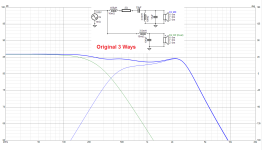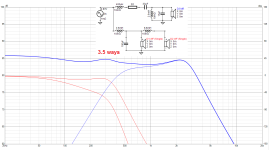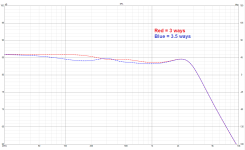I’ve decided to give up on a 3-way build. The crossover for dual 10” woofers to a 2” dome midrange is employed around 450-650 Hz. I found the woofer’s best performance is achieved when the low-pass is only set at below 300Hz. But that will introduce a large gap between woofers and the dome midrange because the dome midrange cannot go as low as 300Hz. I realize that there are two options for me now:
1) go for 3.5 ways, let one woofer play lower midrange continuously from the dome midrange and let another woofer be as a subwoofer, having low crossover point i.e. below 300Hz.
2) go for 4 ways, sell a pair of 10” woofers for a pair of 6-8” woofers. Use the remaining 10” woofers as subwoofers crossed at below 300Hz as well.
Which one is more interesting?
1) go for 3.5 ways, let one woofer play lower midrange continuously from the dome midrange and let another woofer be as a subwoofer, having low crossover point i.e. below 300Hz.
2) go for 4 ways, sell a pair of 10” woofers for a pair of 6-8” woofers. Use the remaining 10” woofers as subwoofers crossed at below 300Hz as well.
Which one is more interesting?
Last edited:
A 2" upper mid dome will generally struggle below about 800 Hz with clean output at higher SPLs in full sized speakers. For a balanced high fidelity performance it either needs to be bigger to cover the lower midrange or a separate lower midrange driver used.
Subwoofers are normally crossed at 80 Hz or below because above this frequency we can hear where sound is coming from which would prevent them from being placed where needed to help control room resonances.
Subwoofers are normally crossed at 80 Hz or below because above this frequency we can hear where sound is coming from which would prevent them from being placed where needed to help control room resonances.
Yes, I will go for the latter. But I’m hesitating whether the separated lower midrange should be from the additional mid-bass driver or could be from the woofer.For a balanced high fidelity performance it either needs to be bigger to cover the lower midrange or a separate lower midrange driver used.
I agree, but here we have two subwoofers individually for left and right channels. So, I don’t think it may require to be crossed at that low frequency (about 80Hz).Subwoofers are normally crossed at 80 Hz or below because above this frequency we can hear where sound is coming from which would prevent them from being placed where needed to help control room resonances.
If you opt to cross a 10" driver at 800 Hz the cone and surround will be bending/flapping/resonating and it won't have a deep low frequency response (if it did it wouldn't be able to cross at 800 Hz). It can be done reasonably well in, for example, competently designed 2 ways with large horns but it is still a compromise in terms of performance compared to simply using a pair of appropriately sized conventional drivers (e.g. 4-6.5" midwoofer and 10-15" woofer or multiple 8-12" woofers).
I already had the 10” woofers in my hand at that moment. And I saw a few commercial speakers did it that way (large dome midrange with 10” woofer combination) such as vintage German: Braun, Canton, Heco, or even American: ADS.why don't you just use a smaller woofer and cross at 800 Hz ? It's so easy, I mean...
You could also just keep all the current drivers and add a 5" or so midrange/midbass to cover the approximately 200-1000 Hz range. Assuming this works with your budget.go for 4 ways, sell a pair of 10” woofers for a pair of 6-8” woofers.
A pair of 10's makes for a potent bass system. If you are truly committed to using a 2" dome midrange, then I like the idea of adding a 5" or 6" driver. Crossovers at approximately 200, 1k, 4k... as @mattstat comments above.
Alternative plan is to skip the 2" dome mid. As @AllenB says, this is a challenging driver to work with. A pair of 10's, with a 5" mid and a 1" dome is quite doable, and there are a lot of driver choices available at range of voltage sensitivities, impedances, and price points. Lower crossover can be anywhere from 200 - 500, and upper crossover can be anywhere from 1.6k to 5k, depending on the tweeter and midrange. This architecture gives you a lot of design flexibility.
Alternative plan is to skip the 2" dome mid. As @AllenB says, this is a challenging driver to work with. A pair of 10's, with a 5" mid and a 1" dome is quite doable, and there are a lot of driver choices available at range of voltage sensitivities, impedances, and price points. Lower crossover can be anywhere from 200 - 500, and upper crossover can be anywhere from 1.6k to 5k, depending on the tweeter and midrange. This architecture gives you a lot of design flexibility.
If you have the system with all drivers, you may just try the 3.5 way approach with a modified crossover or filter setup and hear if it gets better?
Adding a 4th way appears to me the more consequent approach for small 2" dome mid integration, so choose between:
1) changing one of the 10" woofers to a 6" - 8" with good mid / fundamental capabilities as mentioned by you.
2) or adding an additional 6" - 8" with good mid / fundamental capabilities to both 10" woofers.
If there is no more space on the baffle left, you might just put an additional eclosure with the 6-8" on the existing cabinet....
Dependent on the driver and enclosure, you may leave out the highpass for the new kick driver when the spider + encosure air suspension shape a matching mechanical lowpass and protect the driver from high excursions; This can be appreciated for passive xover, to save high costs for the needed big parts for the highpass at low frequencies. 10" woofer(s) then probably only for subwoofer duty <<150Hz. Troels Gravensens often preferres this approach, most of his 4-ways are 3.5-ways from the xover....
- Generally, the vertical response may improve and give a more linear overall power and in-room response, if this is the issue.
- If the issue is distortion/IMD from the 10" woofers, it may even get worse when just one woofer then has to deliver the same SPL in the midrange...
Adding a 4th way appears to me the more consequent approach for small 2" dome mid integration, so choose between:
1) changing one of the 10" woofers to a 6" - 8" with good mid / fundamental capabilities as mentioned by you.
2) or adding an additional 6" - 8" with good mid / fundamental capabilities to both 10" woofers.
If there is no more space on the baffle left, you might just put an additional eclosure with the 6-8" on the existing cabinet....
Dependent on the driver and enclosure, you may leave out the highpass for the new kick driver when the spider + encosure air suspension shape a matching mechanical lowpass and protect the driver from high excursions; This can be appreciated for passive xover, to save high costs for the needed big parts for the highpass at low frequencies. 10" woofer(s) then probably only for subwoofer duty <<150Hz. Troels Gravensens often preferres this approach, most of his 4-ways are 3.5-ways from the xover....
I finally decided to go for the 3.5 ways conversion.
Previously, I played with tweaking the 3 ways and found that the sound from the woofers was the most favourable when the woofers were limited to play below 300Hz. However, the problem was the 2" dome midrange couldn't go any lower, otherwise, a huge gap between drivers would be generated. Still, there's a condition that the woofers would no longer be allowed to play above 300Hz. Therefore, the system need to be fulfilled the gap between woofers and midrange.
To go for 3.5 ways, I've played with simulation on VituixCAD simulator. I experimented by adding a first order inductor to the lower woofer but without changing the original component values. Attached are the results.
Here is the question, is there anything more complicated to be concerned than adding a large inductor to the lower woofers?
Previously, I played with tweaking the 3 ways and found that the sound from the woofers was the most favourable when the woofers were limited to play below 300Hz. However, the problem was the 2" dome midrange couldn't go any lower, otherwise, a huge gap between drivers would be generated. Still, there's a condition that the woofers would no longer be allowed to play above 300Hz. Therefore, the system need to be fulfilled the gap between woofers and midrange.
To go for 3.5 ways, I've played with simulation on VituixCAD simulator. I experimented by adding a first order inductor to the lower woofer but without changing the original component values. Attached are the results.
Here is the question, is there anything more complicated to be concerned than adding a large inductor to the lower woofers?
Attachments
Do you mean post #9?I received a 'like' from Prescott but nuttin' else. I'd like to know if he/she had received the information and maybe discuss about it...you know...forums... knowledge
Yes, they sound wonderful. I, thus, follow their designs (using 2" dome with 10" woofers).
No, it's number six
Again, why don't you use one (1) smaller woofer and forget about past designs?!Do you mean post #9?
Save 2 inch for a dual 6 inch 2,5 way. Best most placement friendly bass I've ever heard. Same speaker suffered reflection in middrange because it didnt have phase plugs.
Bevare that some woofers and midds have "fake" phase plugs that are just phase plugs shaped center domes. I dont know the downsides of this cheaper solution.
Bevare that some woofers and midds have "fake" phase plugs that are just phase plugs shaped center domes. I dont know the downsides of this cheaper solution.
I’ve already answered in post #8.No, it's number six
Again, why don't you use one (1) smaller woofer and forget about past designs?!
“I already had the 10” woofers in my hand at that moment.”
- Home
- Loudspeakers
- Multi-Way
- From 3 to 3.5 or 4 ways


